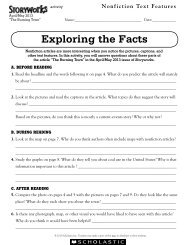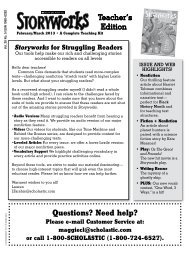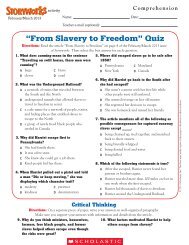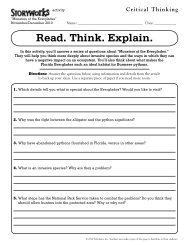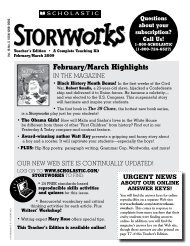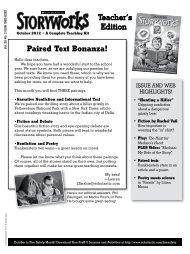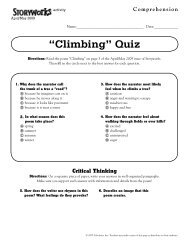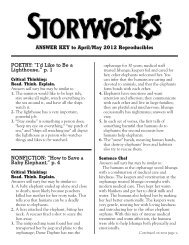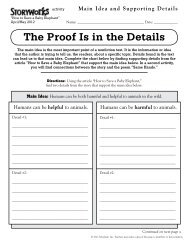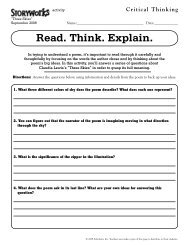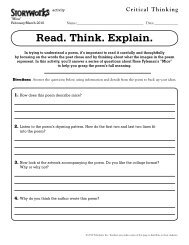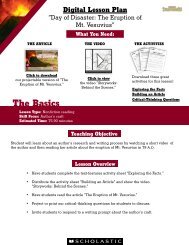Reading & Thinking - Scholastic
Reading & Thinking - Scholastic
Reading & Thinking - Scholastic
Create successful ePaper yourself
Turn your PDF publications into a flip-book with our unique Google optimized e-Paper software.
activity<br />
Name:____________________________________ Date:_____________<br />
<strong>Reading</strong> & <strong>Thinking</strong><br />
Exploring the facts and ideas in a nonfiction article will help you understand it better.<br />
Use this organizer with any of the nonfiction pieces you find in Storyworks.<br />
TiTle<br />
AuThor<br />
Extended <strong>Reading</strong> Comprehension<br />
(for nonfiction articles)<br />
reAding For inFormATion<br />
This article is mainly about ___________________________________________________________.<br />
The main events of the article take place in ___________________ (name a location).<br />
The year or time period is __________________. Some important people mentioned in the article are<br />
__________________________________________________________________________________.<br />
Here are some facts I learned from this article (Write at least four):<br />
___________________________________________________________________________________<br />
___________________________________________________________________________________<br />
______________________________________________________________________________________<br />
_____________________________________________________________________________________.<br />
Put a star (*) by the facts you wrote above that are important in explaining what the article is about.<br />
Put an X by the facts that you find really interesting. (Some facts might have both a star and an X.)<br />
The facts with a star are important because<br />
1. _________________________________________________________________________________<br />
___________________________________________________________________________________<br />
2. _________________________________________________________________________________<br />
___________________________________________________________________________________<br />
The facts with an X are interesting because<br />
1. _________________________________________________________________________________<br />
___________________________________________________________________________________<br />
2. _________________________________________________________________________________<br />
___________________________________________________________________________________<br />
Continued<br />
© 2008 <strong>Scholastic</strong> Inc. Teachers may make copies of this page to distribute to their students.
activity<br />
Extended <strong>Reading</strong> Comprehension<br />
(for nonfiction articles)<br />
<strong>Reading</strong> & <strong>Thinking</strong> page 2<br />
mAin ideA<br />
The main idea of this story is ___________________________________________________________<br />
__________________________________________________________________________________.<br />
Here are some details that support the main idea:<br />
1. _________________________________________________________________________________<br />
___________________________________________________________________________________<br />
2. _________________________________________________________________________________<br />
___________________________________________________________________________________<br />
3. _________________________________________________________________________________<br />
___________________________________________________________________________________<br />
Another idea presented in this story is ___________________________________________________<br />
__________________________________________________________________________________.<br />
Here are some details that support that idea:<br />
1. _________________________________________________________________________________<br />
___________________________________________________________________________________<br />
2. _________________________________________________________________________________<br />
___________________________________________________________________________________<br />
3. _________________________________________________________________________________<br />
___________________________________________________________________________________<br />
AuThor’s PurPose<br />
I think the author wrote this article because _______________________________________________<br />
___________________________________________________________________________________<br />
I think the author expresses the viewpoint, or opinion, that __________________________________<br />
___________________________________________________________________________________<br />
___________________________________________________________________________________<br />
I agree/disagree (circle one) with the author’s viewpoint because ______________________________<br />
___________________________________________________________________________________<br />
Continued<br />
© 2008 <strong>Scholastic</strong> Inc. Teachers may make copies of this page to distribute to their students.
activity<br />
Extended <strong>Reading</strong> Comprehension<br />
(for nonfiction articles)<br />
<strong>Reading</strong> & <strong>Thinking</strong> page 3<br />
ConneCTions<br />
Here’s how this article relates to (fill in at least one)<br />
Something else I read:_________________________________________________________________<br />
__________________________________________________________________________________.<br />
Something else I know about:___________________________________________________________<br />
__________________________________________________________________________________.<br />
Something in my own life:_____________________________________________________________<br />
__________________________________________________________________________________.<br />
resPonding To liTerATure<br />
Would you recommend this article to a friend? Why or why not?<br />
___________________________________________________________________________________<br />
___________________________________________________________________________________<br />
___________________________________________________________________________________<br />
© 2008 <strong>Scholastic</strong> Inc. Teachers may make copies of this page to distribute to their students.
activity<br />
Name:____________________________________ Date:_____________<br />
<strong>Reading</strong> & <strong>Thinking</strong><br />
Exploring the facts and ideas in a nonfiction article will help you understand it better.<br />
Use this worksheet to help you understand any nonfiction article you read in Storyworks.<br />
TiTle OF ArTicle<br />
A. BeFOre reAding<br />
1. Look at the photos or pictures. Read the captions. What can you predict the story will mainly be<br />
about? Circle one and explain.<br />
A person If so, who? ____________________________________________________________<br />
An event If so, what? ____________________________________________________________<br />
Something else If so, what? ______________________________________________________<br />
2. Is there a map along with the article? Yes No<br />
<strong>Reading</strong> Comprehension<br />
(for nonfiction articles)<br />
If yes, what is it a map of? _________________________________________________________<br />
Where do you think the story takes place? ____________________________________________<br />
When do you think it takes place? __________________________________________________<br />
B. during reAding<br />
3. Start by reading the subtitles, or headings of each section of the article.<br />
How many sections does this article have? ____________________________________________<br />
4. Tell what each section is mainly about.<br />
The first section is mainly about: __________________________________________________<br />
The second section is mainly about: _______________________________________________<br />
The third section is mainly about: _________________________________________________<br />
The fourth section is mainly about: ________________________________________________<br />
(Cross out if there are only three sections.)<br />
5. Write three words from the article that you didn’t know before. Then write their meanings, using<br />
context clues or the dictionary to help you.<br />
______________________________________________________________________________<br />
______________________________________________________________________________<br />
______________________________________________________________________________<br />
Continued<br />
© 2010 <strong>Scholastic</strong> Inc. Teachers may make copies of this page to distribute to their students.
activity<br />
<strong>Reading</strong> Comprehension<br />
(for nonfiction articles)<br />
<strong>Reading</strong> & <strong>Thinking</strong> page 2<br />
c. AFTer reAding<br />
6. Timeline<br />
Put the important parts of the article in the order in which they occurred. Write what happened<br />
first, next, and last.<br />
FirsT<br />
______________________________<br />
______________________________<br />
______________________________<br />
______________________________<br />
______________________________<br />
neXT<br />
______________________________<br />
______________________________<br />
______________________________<br />
______________________________<br />
______________________________<br />
neXT<br />
______________________________<br />
______________________________<br />
______________________________<br />
______________________________<br />
______________________________<br />
lAsT<br />
______________________________<br />
______________________________<br />
______________________________<br />
______________________________<br />
______________________________<br />
7. What was the most interesting part of the article to you? Why was it interesting?<br />
___________________________________________________________________________________<br />
___________________________________________________________________________________<br />
___________________________________________________________________________________<br />
___________________________________________________________________________________
April/May 2010<br />
activity<br />
“The Day Aliens Attacked America” Quiz<br />
Directions: Read the nonfiction article “The Day Aliens Attacked America” on page 18 of<br />
the April/May 2010 issue of Storyworks. Then fill in the circle next to the best answer for each question.<br />
1. What is the main idea of this article?<br />
A We should be prepared for an alien attack.<br />
B Aliens exist only in fiction.<br />
C Another form of life probably exists beyond<br />
Earth.<br />
D Orson Welles tricked the nation in a radio<br />
broadcast.<br />
2. In what year did the broadcast of<br />
“War of the Worlds” cause an uproar?<br />
A 1898 C 1983<br />
B 1938 D 1999<br />
3. How many stars are in our galaxy?<br />
A 70 sextillion<br />
B 400<br />
C about 1 million<br />
D more than 200 billion<br />
4. It is likely that a planet that supports life<br />
would have . . .<br />
A water.<br />
B oxygen.<br />
C rocky surfaces.<br />
D both A and C<br />
9. What conclusions can you draw from<br />
looking at the timeline on pages 20-21?<br />
Comprehension<br />
Name:____________________________________ Date:_____________<br />
5. How do scientists get information from the<br />
Hubble Space Telescope?<br />
A They look through its viewfinder.<br />
B The telescope records sounds in space.<br />
C The telescope sends pictures back to Earth.<br />
D Scientists journey through space with the<br />
telescope.<br />
6. About how long does it take for Hubble to<br />
orbit the Earth?<br />
A three weeks C 90 days<br />
B 90 minutes D two months<br />
7. What is amazing about the planet that the<br />
Kepler mission recently discovered?<br />
A It is mostly covered by water.<br />
B It has a perfect climate for humans.<br />
C It has a blue sky.<br />
D It revolves around our sun.<br />
8. Which of these statements is a fact?<br />
A People are too concerned about aliens.<br />
B Many scientists believe life beyond Earth<br />
exists.<br />
C Kepler is our most important space mission.<br />
D all of the above<br />
Critical <strong>Thinking</strong><br />
Directions: On a separate piece of paper, write your answers in well-organized paragraphs.<br />
Make sure you support your answer with information and details from the article!<br />
10. Will scientists find extraterrestrial life in<br />
your lifetime? Explain your reasoning.<br />
© 2010 <strong>Scholastic</strong> Inc. Teachers may make copies of this page to distribute to their students.
activity<br />
Critical <strong>Thinking</strong><br />
“The Day Aliens Attacked America”<br />
April/May 2010<br />
Name:____________________________________ Date:_____________<br />
Read. Think. Explain.<br />
In this activity, you’ll answer a series of questions about “The Day Aliens Attacked America,”<br />
which will help you think more deeply about space exploration and whether there is life on other<br />
planets in the universe. You’ll also think about “The War of the Worlds” broadcast<br />
and how it affected Americans in the late 1930s.<br />
Directions: Answer the questions below, using information and details from the story<br />
to back up your ideas. Use a separate piece of paper if you need more room.<br />
1. Why do you think people have always been fascinated by space?<br />
2. What details in the story illustrate how large the universe is and what a small part<br />
our planet is?<br />
3. According to scientists, in what ways would a planet that supports life probably be<br />
similar to Earth?<br />
4. Why is the discovery of a planet that is mostly covered by water important?<br />
5. What was the effect of Orson Welles’s radio broadcast of “The War of the Worlds”?<br />
Why do you think so many people believed it was true?<br />
© 2010 <strong>Scholastic</strong> Inc. Teachers may make copies of this page to distribute to their students.
Sentence 1:<br />
Sentence 2:<br />
Sentence 3:<br />
Sentence 4:<br />
activity<br />
Vocabulary<br />
“The Day Aliens Attacked America”<br />
April/May 2010<br />
Name:____________________________________ Date:_____________<br />
These Words Are out of This World!<br />
This issue’s nonfiction article “The Day Aliens Attacked America” includes some great words<br />
to use to talk about life in outer space and down here on Earth. In this activity, you will use a<br />
dictionary to match the words below to their definitions.<br />
Directions: Match each word on the left to its definition on the right.<br />
Then choose four of the words and write a sentence using each one.<br />
beaming a group of stars that forms a shape<br />
complex sending out through space<br />
constellation made it possible to do something<br />
deceived perfect, resembling paradise<br />
enabled very complicated<br />
orbit sudden feeling of great fright<br />
panic tricked into believing something untrue<br />
paradisical the invisible path followed by an object<br />
circling a planet, the sun, etc.<br />
© 2010 <strong>Scholastic</strong> Inc. Teachers may make copies of this page to distribute to their students.
activity<br />
“The Day Aliens Attacked America”<br />
April/May 2010<br />
try this<br />
with a<br />
partner!<br />
Creative <strong>Thinking</strong>/<br />
Conducting an Interview<br />
Name:____________________________________ Date:_____________<br />
Interview With an Alien<br />
What if there are other life forms in the universe? Wouldn’t it be great to talk to one?<br />
In this activity, you will do just that, either alone or with a partner, by brushing up on your<br />
interviewing skills. Use your imagination to come up with creative questions—and answers!<br />
Directions: First, find a partner. Decide who will be the interviewer and who will be the alien.<br />
Then use your imagination to come up with questions (and answers!) about life on other planets.<br />
(If you are doing this activity on your own, you can play both roles!)<br />
Step 1: think of the questions you want to ask the alien.<br />
Before you conduct an interview, it’s always smart to write a list of questions you want to ask.<br />
That way, you’ll have all the information you need to write a well-organized report.<br />
Here are a list of possible questions:<br />
1. How would you describe yourself? (Do you have big eyes? a green face? suction cups for feet?)<br />
2. What kind of personality do you have? (Are you friendly? mean? shy? gentle?)<br />
3. What kind of food do you eat? (Do you like human food? bugs? a type of food unknown to humans?)<br />
4. How would you describe your home? (Do you live on a planet, a star, an asteroid? What does it look like?)<br />
5. How do you get around? (Can you fly on your own? Do you travel by spaceship or car?)<br />
6. What’s your family like? (Does your species have families like we do on Earth?)<br />
Other important questions you might have:<br />
7.<br />
8.<br />
9.<br />
10.<br />
Continued8<br />
© 2010 <strong>Scholastic</strong> Inc. Teachers may make copies of this page to distribute to their students.
“The Day Aliens Attacked America”<br />
April/May 2010<br />
1.<br />
2.<br />
3.<br />
4.<br />
5.<br />
6.<br />
7.<br />
8.<br />
9.<br />
10.<br />
activity Creative <strong>Thinking</strong>/<br />
Conducting an Interview, page 2<br />
Step 2: Ask your partner (or your imaginary alien) the questions you thought of<br />
in Step 1. then write the answers below.<br />
On Your Own<br />
Write a well-organized paragraph about the alien<br />
you interviewed. Be sure to include a lot of details<br />
and juicy descriptions!<br />
With a Partner<br />
Create a poster about the alien, listing important<br />
facts and descriptions of its home. Or, you can draw<br />
pictures! Then present your poster to the class.<br />
© 2010 <strong>Scholastic</strong> Inc. Teachers may make copies of this page to distribute to their students.
activity<br />
Research/Sequencing<br />
“The Day Aliens Attacked America”<br />
April/May 2010<br />
Name:____________________________________ Date:_____________<br />
Dates in Time and Space<br />
Scientific breakthroughs in the past 60 years have taught us a lot about the universe! In this<br />
activity, you will research some of these events and place them on a timeline.<br />
Directions: Reread “The Day Aliens Attacked America,” noting the dates of each event listed in the boxes<br />
on the right. In the boxes on the left, do research to find the dates of four other important moments in space<br />
travel history. Then connect each event to the closest place on the timeline. We’ve added one date for you.<br />
SPACE AND US<br />
(FROM YOUR RESEARCH)<br />
A dog named Laika<br />
becomes the first living<br />
animal to travel to space.<br />
Date: _____________<br />
A space probe, Huygens,<br />
lands on the first non-<br />
Earth moon (Saturn’s).<br />
Date: _____________<br />
Neil Armstrong becomes<br />
the first person to walk<br />
on the moon.<br />
Date: _____________<br />
NASA, a national<br />
association for the study<br />
of space is founded.<br />
Date: _____________<br />
1950<br />
1960<br />
1970<br />
1980<br />
1990<br />
2000<br />
2010<br />
ALIENS AND US<br />
(FROM THE ARTICLE)<br />
Avatar, the highestgrossing<br />
film of all time,<br />
is released.<br />
Date: _____________ 2009<br />
UFOs land on Earth in<br />
Close Encounters of the<br />
Third Kind.<br />
Date: _____________<br />
The Hubble Space<br />
Telescope is launched to<br />
take pictures of space.<br />
Date: _____________<br />
The Kepler Space<br />
Telescope is launched to<br />
find Earth-like planets.<br />
Date: _____________<br />
Critical <strong>Thinking</strong><br />
Choose one of the events written in the boxes above. On a separate sheet of paper, write a well-organized<br />
paragraph explaining why you think it was an important breakthrough in space travel.<br />
© 2010 <strong>Scholastic</strong> Inc. Teachers may make copies of this page to distribute to their students.
activity<br />
Fact vs. Fiction<br />
“The Day Aliens Attacked America”<br />
April/May 2010<br />
Name:____________________________________ Date:_____________<br />
Distinguishing Fact From Fiction<br />
After hearing a radio broadcast on October 31, 1938, thousands of Americans believed they<br />
were under attack by aliens. It turns out the story that aired was fiction—the events described<br />
never happened. In this activity, you will practice telling the difference between fact and fiction<br />
in “The Day Aliens Attacked America.”<br />
Directions: Circle F for fact or Fi for fiction for each statement below about the article<br />
“The Day Aliens Attacked America.” Then follow the writing prompts on the second page.<br />
1. 2. 3. 4.<br />
There are more<br />
than 200 billion<br />
stars in the Milky<br />
Way.<br />
F Fi<br />
5. 6. 7. 8.<br />
If a planet is too<br />
close to its star,<br />
everything on<br />
its surface gets<br />
broiled.<br />
F Fi<br />
On October 31,<br />
1938, aliens from<br />
Mars attacked<br />
New York City.<br />
F Fi<br />
The Kepler<br />
Space Telescope<br />
was launched to<br />
search for Earthlike<br />
planets in the<br />
Milky Way.<br />
F Fi<br />
In 1951, an<br />
extraterrestrial<br />
named Klaatu<br />
arrived on Earth.<br />
F Fi<br />
A giant explosion<br />
occured on Mars<br />
in 1938.<br />
F Fi<br />
The Hubble<br />
Space Telescope<br />
has taken more<br />
than 100,000<br />
pictures of distant<br />
galaxies.<br />
F Fi<br />
There are<br />
millions of Earthlike<br />
planets<br />
that exist in far<br />
corners of the<br />
universe.<br />
F Fi<br />
© 2010 <strong>Scholastic</strong> Inc. Teachers may make copies of this page to distribute to their students.
activity<br />
“The Day Aliens Attacked America”<br />
April/May 2010<br />
Fact 1:<br />
Fact 2:<br />
Fact 3:<br />
Fact 4:<br />
Fact 5:<br />
Fact vs. Fiction<br />
Distinguishing Fact From Fiction, page 2<br />
STep 2: Find FIVe more facts from the article about space exploration<br />
over the past 20 years and write them below.<br />
Critical <strong>Thinking</strong><br />
1. Using the facts you wrote down above, write a well-organized paragraph about space exploration over the<br />
past 20 years. Make sure to include information about the Hubble and Kepler Space Telescopes.<br />
2. Now imagine that either Hubble or Kepler actually discovered an Earth-like planet where other life forms<br />
lived! What would that planet look like? What would the atmosphere be like? Describe the planet and the<br />
beings that live on it in great detail. Let your imagination run wild!



